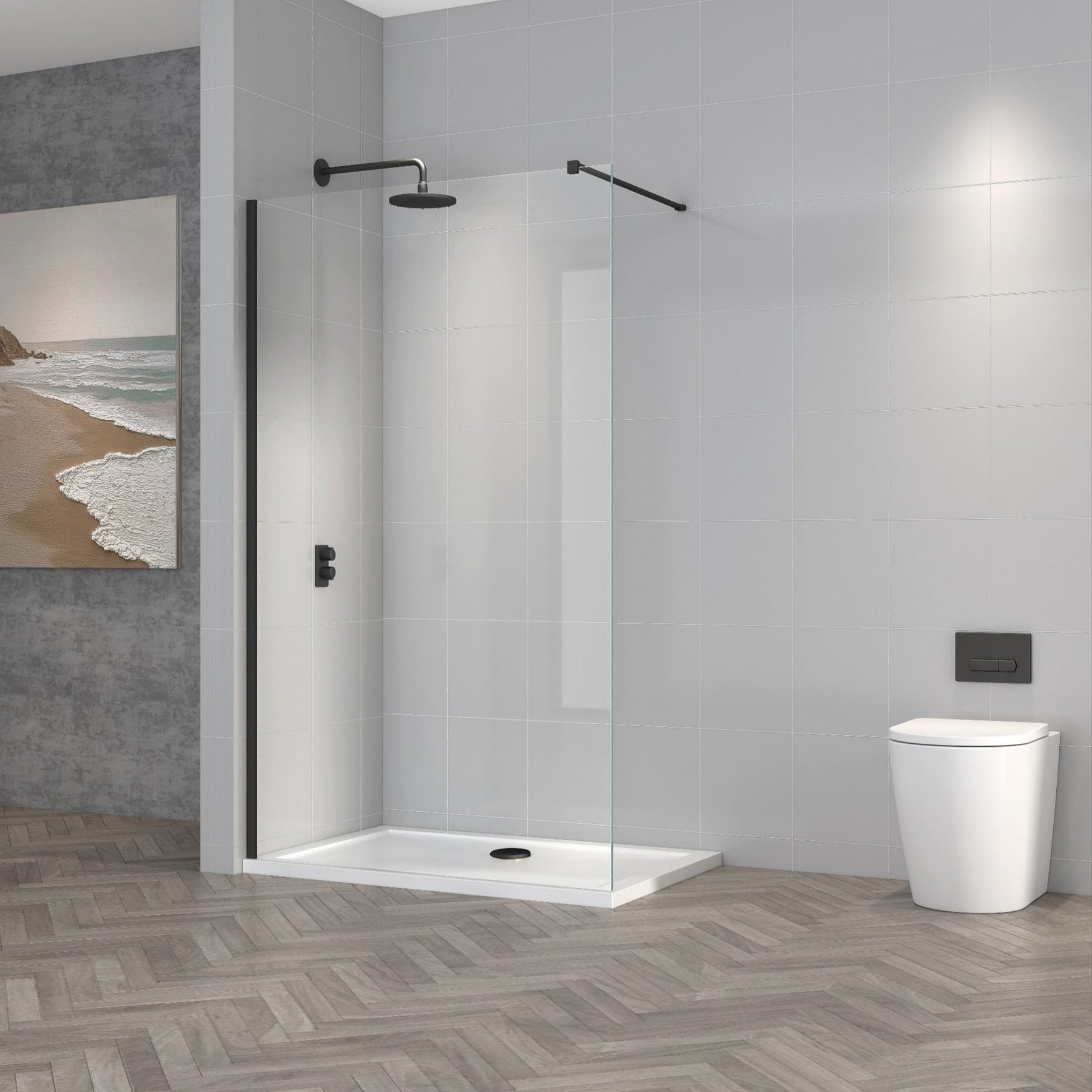01 864 5119

Top Tips for Buying Wet Room Screens
Creating a wet room is one of the most rewarding bathroom upgrades you can make in your Irish home, but choosing the right screen can make or break the entire project. Get it right, and you'll have a sleek, modern space that feels luxurious and works brilliantly for years. Get it wrong, and you'll be dealing with leaks, wobbles, and endless frustration.
Start with Your Space, Not Your Dreams
Before you fall in love with that stunning oversized screen in the brochure, grab a tape measure and face reality. The golden rule is simple: allow at least 500-600mm for comfortable access into your shower area. This isn't negotiable anything narrower feels cramped and makes daily use awkward.
Measure twice, buy once. If you've got a 1700mm space, you're looking at screens between 1100-1200mm wide. Mark this out on your bathroom floor with masking tape and actually walk through the gap. You'll quickly discover whether it feels comfortable for your household's morning rush or feels more like squeezing through a porthole.
Consider your shower's personality too. A powerful rainfall head or multiple body jets create significantly more spray than a standard mixer shower. If you love a vigorous shower, you'll need more coverage than someone who prefers a gentle sprinkle.
Glass Thickness: Where Quality Meets Reality
8mm toughened glass hits the sweet spot for most Irish homes. It feels substantial when you touch it, handles daily family life brilliantly, and represents excellent value. Most quality suppliers offer 8mm as standard, and there's good reason for this.
6mm glass works perfectly for lighter-use areas like guest bathrooms or where practicality trumps luxury. It's completely safe, meets all required standards, but feels lighter in operation. Some people associate this with lower quality, but that's more perception than reality.
10mm glass is the premium choice for those wanting that hotel-like feel. It's noticeably heavier, more substantial, and definitely looks the part. However, it requires beefier support systems and more careful installation only worth it if the luxury feel genuinely matters to you.
For wet room screens specifically, thicker is generally better since they're standalone panels held by support arms rather than being fully framed. Most wet room installations work brilliantly with 8mm glass, though 10mm adds that extra sense of solidity.
Size Matters: Getting the Measurements Right
Minimum viable wet room size is around 1200mm, but you'll be living with limitations at this size. Water escape is almost guaranteed, and you'll feel cramped. If your space is this tight, honestly consider whether a traditional shower enclosure might serve you better.
1400-1600mm spaces work beautifully with 800-1000mm screens, leaving plenty of room for comfortable movement whilst containing most spray. This is the sweet spot for many Irish family bathrooms where space is at a premium but functionality can't be compromised.
Larger spaces above 1700mm give you real flexibility. You can run generous screens and still have comfortable access, or create walk-through designs that feel genuinely luxurious. These larger installations really showcase wet room living at its best.
Height is usually straightforward most screens come at 1950mm or 2000mm, which works perfectly with standard Irish ceiling heights whilst providing excellent splash coverage.
Frame Finishes: Choosing Your Style Statement
Chrome remains the classic choice and works with virtually everything. It's timeless, won't date, and perfect if you're planning to sell or prefer safe, traditional styling. The downside? It shows water spots more readily than other finishes.
Matt black has become incredibly popular and creates genuine drama without being overwhelming. It works particularly well with contemporary tiles and natural materials. The finish is also more forgiving for water spots, making maintenance easier.
Brushed brass brings warmth and works beautifully with natural materials and warmer colour schemes. It's having a real moment in Irish interiors and adds that premium boutique hotel feel. Just ensure it coordinates with your other bathroom fittings.
Gunmetal and bronze finishes are emerging as sophisticated alternatives for those wanting something different but not too bold. They work particularly well in larger wet rooms where they can make a proper statement.
Glass Options: Clear, Fluted, or Frosted?
Clear glass maximises light and makes spaces feel as open as possible. It's the obvious choice for smaller wet rooms or anywhere you want to preserve the sense of space. The trade-off is that everything's on display.
Fluted glass offers privacy with serious style. Those vertical ridges create visual interest whilst obscuring the view perfect if your wet room is visible from other areas. The texture also brilliantly hides water spots between cleaning sessions.
Frosted glass provides maximum privacy but can make spaces feel more enclosed. It works well in larger wet rooms where you're not worried about the space feeling cramped, and creates a softer, more spa-like atmosphere.
Support Arms: The Unsung Heroes
Any screen over 700mm wide typically needs a support arm for stability. These aren't afterthoughts they're essential for safety and longevity. Wall-to-glass arms are most common and work well in most installations.
Ceiling support arms provide exceptional stability but require solid ceiling construction. They're particularly useful for larger screens or where wall fixing isn't ideal.
45-degree support arms offer a middle ground, providing excellent support with less visual impact than straight arms. They work particularly well in contemporary installations where clean lines matter.
The key is ensuring your chosen support matches your screen's weight and your wall's construction. Irish homes vary enormously from solid stone cottages to modern block builds so professional advice on fixing methods is invaluable.
Common Mistakes That'll Cost You
Don't assume bigger screens automatically provide better water containment. Poor positioning often causes more problems than screen size. Think about water flow patterns and body positioning when showering.
Never skimp on installation. Poor fitting causes most wet room problems. Experienced installers understand Irish building methods, know about building regulations, and carry proper insurance. It's worth paying for expertise.
Don't ignore return panels. These small additional screens at 90 degrees to your main panel can dramatically improve water containment in tighter spaces. They're often the difference between success and soggy bathroom floors.
Installation Considerations for Irish Homes
Wall strength matters more than you think. Irish homes vary enormously in construction. Victorian terraces with solid stone walls, 1930s houses with cavity walls, and modern timber-frame houses all require different fixing approaches.
Waterproofing comes first. Your screen is only as good as the waterproofing behind it. Ensure proper tanking is completed before any screen installation, particularly around fixing points where water ingress could cause serious problems.
Building regulations apply. Wet rooms fall under Part H of the Building Regulations in Ireland. Ensure your installation complies, particularly regarding drainage, ventilation, and structural waterproofing.
Dealing with Ireland's Humidity
Ireland's naturally humid climate means your wet room will face extra challenges. Proper ventilation becomes even more critical to prevent mould and condensation problems. Ensure your extractor fan is powerful enough for the space and runs for at least 15 minutes after showering.
Easy-clean glass coatings are particularly worthwhile in Irish conditions. They help water sheet off more easily and reduce the buildup of limescale and soap scum that Ireland's hard water can cause.
Maintenance: Keeping Things Sparkling
Daily maintenance takes 30 seconds but makes a massive difference. A quick wipe with a squeegee after showering prevents water spots building up. It's the single most effective thing you can do.
Weekly cleaning with a vinegar-and-water solution or mild bathroom cleaner keeps everything fresh. Avoid abrasive products that can damage protective coatings many modern screens have easy-clean treatments that make maintenance simpler.
Monthly checks of seals and fixings prevent small problems becoming expensive disasters. Loose screws or degraded sealing are much cheaper to fix early than after water damage occurs.
Future-Proofing Your Choice
Consider your household's changing needs. Young families might prioritise easy access and durability, whilst older adults might value stability and minimal maintenance more highly. Think about how your needs might evolve.
Classic finishes have broader appeal for resale purposes. Chrome and clear glass work with more design styles than highly personalised choices. If you're planning to sell within a few years, play it safe.
Quality pays off long-term. Well-made screens with proper installation should serve you for 15-20 years. Cheaper screens might seem attractive initially but often require replacement much sooner.
Making Your Final Decision
Don't rush the decision. A wet room screen should serve you well for many years, so take time to consider how it fits your lifestyle, not just your current bathroom design.
The perfect wet room screen balances your space, practical needs, and design preferences whilst providing years of reliable service. Take time to measure carefully, consider your options thoughtfully, and invest in quality installation. Get these fundamentals right, and you'll enjoy the luxury of a beautifully designed wet room that enhances your daily routine for many years to come.
